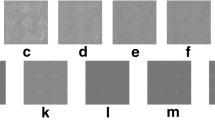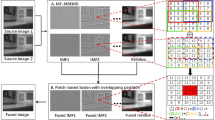Abstract
Bidimensional empirical mode decomposition (BEMD) is a new method for multi-scale image decomposition. In order to forbid useless information to cause an adverse impact on results and make the process have a better self-adaptability, this paper presents a new multi-scale image fusion method, which combines pulse coupled neural network (PCNN) and compressed sensing, and uses them in the BEMD. At first, BEMD processes the original images decomposed into multiple bidimensional intrinsic mode function (BIMFs) and a residual image. Then after doing compression measurement on each layer of BIMFS, we can get compression measurement coefficients. The coefficients at the same layer do the PCNN image fusion, and we can get measurement sampling BIMFs. And then after measurement sampling BIMFs reconstructed, we can get the final BIMFs. The residual images do the fusion based on entropy weight to get the final residual image. At last, after BEMD inverse transform, the final BIMFs and the final residual image get the result image. Experimental studies have shown that compared with other multi-scale decompositions-based image fusion algorithms, the algorithm in this paper has a better performance in terms of objective criteria and visual appearance.




Similar content being viewed by others
References
Balter J, Hsu S, Vineberg K, Lawrence TS, Feng MU, Tsien CI, Cao Y (2014) Volumetric arc treatment planning in the brain using MRI-derived synthetic CT images. Int J Radiat Oncol Biol Phys 90(1Suppl):S201
Barber CB, Dobkin DP, Huhdanpaa H (1996) The quickhull algorithm for convex hulls. ACM Trans Math Softw 22(4):469–483
Barbieria AL, de Arrudaa GF, Rodriguesc FA, Brunoa OM, da Fontoura Costaa L (2011) An entropy-based approach to automatic image segmentation of satellite images. Phys Sect A 390(3):512–518
Bhuiyan SMA, Adhami RR, Khan JF (2008a) A novel approach of fast and adaptive bidimensional empirical mode decomposition. In: IEEE international conference on acoustics, speech and signal processing. IEEE, pp 1313–1316
Bhuiyan SMA, Adhami RR, Khan JF (2008b) Fast and adaptive bidimensional empirical mode decomposition using order-statistics filter based envelope estimation. EURASIP J Adv Signal Process 2008(1):1–18
Bhuiyan SMA, Attoh-Okine NO, Barner KE, Ayenu-Prah AY, Adhami RR (2009) Bidimensional empirical mode decomposition using various interpolation techniques. Adv Adapt Data Anal 1(02):309–338
Burt P, Adelson E (1983) The Laplacian pyramid as a compact image code. IEEE Trans Commun 31(4):532–540
Cai TT, Wang L (2011) Orthogonal matching pursuit for sparse signal recovery with noise. IEEE Trans Inf Theory 57(7):4680–4688
Chen Y, Qin Z (2015) Gradient-based compressive image fusion. Front Inf Technol Electron Eng 16(3):227–238
Chen YF, Sang N (2015) Attention-based hierarchical fusion of visible and infrared images. Opt Int J Light Electron Opt 126(23):4243–4248
Chen Y, Wang L, Sun Z, Jiang Y, Zhai G (2010) Fusion of color microscopic images based on bidimensional empirical mode decomposition. Opt Express 18(21):21757–21769
Chen BJ, Shu HZ, Coatrieux G, Chen G, Sun XM, Coatrieux J-L (2015) Color image analysis by quaternion-type moments. J Math Imaging Vis 51(1):124–144
Cui GM, Feng HJ, Xu ZH, Li Q, Chen YT (2015) Detail preserved fusion of visible and infrared images using regional saliency extraction and multi-scale image decomposition. Opt Commun 341(15):199–209
Da Cunha AL, Zhou JP, Do MN (2006) The nonsubsampled contourlet transform: theory, design, and applications. IEEE Trans Image Process 15(10):3089–3101
Damerval C, Meignen S, Perrier V (2005) A fast algorithm for bidimensional EMD. IEEE Signal Process Lett 12(10):701–704
Ding S, Zhao X, Xu H, Zhu Q, Xue Y (2018) NSCT–PCNN image fusion based on image gradient motivation. IET Comput Vis 12(4):377–383
Do MN, Vetterli M (2005) The contourlet transform: an efficient directional multiresolution image representation. IEEE Trans Image Process 14(12):2091–2106
Donoho DL (2006) Compressed sensing. IEEE Trans Inf Theory 52(4):6896–6904
Eckhorn R, Reitboeck HJ, Arndt M, Dicke P (1990) Feature linking via synchronization among distributed assemblies: simulations of results from cat visual cortex. Neural Comput 2(3):293–307
Feng X, Li C, Hu KQ (2014) Infrared and visible light image fusion based on depth boltzmann models. Acta Phys Sin 63(18):215–223
James AP, Dasarathy BV (2014) Medical image fusion: a survey of the state of the art. Inf Fusion 1(19):4–19
Jia J, Jiao LC, Sun Q (2007) Multi-sensor image fusion based on non-subsampled contourlet transform. Acta Electron Sin 35(10):1934–1938
Kong WW, Zhang LJ, Lei Y (2014) Novel fusion method for visible light and infrared images based on NSST–SF–PCNN. Infrared Phys Technol 65:103–112
Liu SC, Zhang YF, Ma PH, Lu B, Su H (2011) A novel spatial interpolation method based on the integrated RBF neural network. Procedia Environ Sci 10(Part A):568–575
Mandeville JA, Gnessin E, Lingeman JE (2015) Imaging evaluation in the patient with renal stone disease. Semin Nephrol 31(3):254–258
Niu HX, Chen EQ, Qi L, Guo X (2015) Image registration based on fractional Fourier transform. Opt Int J Light Electron Opt 126(23):3889–3893
Nunes JC, Bouaoune Y, Delechelle E, Niang O, Bunel P et al (2003) Image analysis by bidimensional empirical mode decomposition. Image Vis Comput 21(12):1019–1026
Qiao L, Niu K, Wang N, Peng L (2011) Perfect reconstruction image modulation based on BEMD and quaternionic analytic signals. Sci China Inf Sci 54(12):2602–2614
Robb A (2002) 2D empirical mode decompositions in the spirit of image compression. Proc SPIE Int Soc Opt Eng 4738(7):1–8
See J, Fauzi MFA, Eswaran C (2013) Fusing cluster-centric feature similarities for face recognition in video sequences. Pattern Recogn Lett 34(16):2057–2064
Tian Y, Zhao K, Xu YP, Peng FY (2011) An image compression method based on the multi-resolution characteristics of BEMD. Comput Math Appl 61(8):2142–2147
Trusiak M, Patorski K, Wielgus M (2012) Adaptive enhancement of optical fringe patterns by selective reconstruction using FABEMD algorithm and Hilbert spiral transform. Opt Express 20(21):23463–23479
Trusiak M, Wielgus M, Patorski K (2014) Advanced processing of optical fringe patterns by automated selective reconstruction and enhanced fast empirical mode decomposition. Opt Lasers Eng 52(1):230–240
Trusiak M, Służewski Ł, Patorski K (2016) Single shot fringe pattern phase demodulation using Hilbert–Huang transform aided by the principal component analysis. Opt Express 24(4):4221–4238
Wang L, Lu K, Liu P (2015) Compressed sensing of a remote sensing image based on the priors of the reference image. IEEE Geosci Remote Sens Lett 12(4):736–740
Wielgus M, Antoniewicz A, Bartyś M et al (2012) Fast and adaptive bidimensional empirical mode decomposition for the real-time video fusion. In: International conference on information fusion. IEEE, pp 649–654
Yang M, de Hoog F (2015) Orthogonal matching pursuit with thresholding and its application in compressive sensing. IEEE Trans Signal Process 63(20):5479–5486
Yang SY, Wang M, Jiao LC (2012) Contourlet hidden Markov Tree and clarity–saliency driven PCNN based remote sensing images fusion. Appl Soft Comput 12(1):228–237
Yao Y, Guo P, Xin X, Jiang ZH (2014) Image fusion by hierarchical joint sparse representation. Cogn Comput 6(3):281–292
Zhao WD, Zhao J, Xu ZJ (2013) Multi-source image fusion based on structure tensor calculus. Acta Phys Sin 62(21):164–170
Acknowledgements
This work is supported by the National Natural Science Foundations of China (Nos. 61672522, 61379101) and the National Key Basic Research Program of China (No. 2013CB329502).
Author information
Authors and Affiliations
Corresponding author
Ethics declarations
Conflict of interest
Shifei Ding declares that he has no conflict of interest. Peng Du declares that he has no conflict of interest. Xingyu Zhao declares that he has no conflict of interest. Qiangbo Zhu declares that he has no conflict of interest. Yu Xue declares that he has no conflict of interest.
Informed consent
All procedures followed were in accordance with the ethical standards of the responsible committee on human experimentation (institutional and national) and with the Helsinki Declaration of 1975, as revised in 2008 (5). Additional informed consent was obtained from all patients for which identifying information is included in this article.
Human and animal rights
This article does not contain any studies with human or animal subjects performed by the any of the authors.
Additional information
Communicated by V. Loia.
Rights and permissions
About this article
Cite this article
Ding, S., Du, P., Zhao, X. et al. BEMD image fusion based on PCNN and compressed sensing. Soft Comput 23, 10045–10054 (2019). https://doi.org/10.1007/s00500-018-3560-8
Published:
Issue Date:
DOI: https://doi.org/10.1007/s00500-018-3560-8




